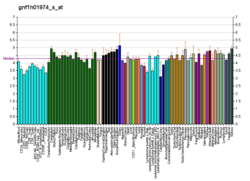| OR10Z1 |
|---|
|
| Identifiers |
|---|
| Aliases | OR10Z1, OR1-15, olfactory receptor family 10 subfamily Z member 1 |
|---|
| External IDs | MGI: 3030253; HomoloGene: 72017; GeneCards: OR10Z1; OMA:OR10Z1 - orthologs |
|---|
| Gene location (Human) |
|---|
 | | Chr. | Chromosome 1 (human)[1] |
|---|
| | Band | 1q23.1 | Start | 158,605,268 bp[1] |
|---|
| End | 158,612,514 bp[1] |
|---|
|
| Gene location (Mouse) |
|---|
 | | Chr. | Chromosome 1 (mouse)[2] |
|---|
| | Band | 1|1 H3 | Start | 174,076,080 bp[2] |
|---|
| End | 174,079,627 bp[2] |
|---|
|
| RNA expression pattern |
|---|
| Bgee | | Human | Mouse (ortholog) |
|---|
| Top expressed in | - testicle
- bone marrow
- nucleus accumbens
- putamen
- Brodmann area 9
- prefrontal cortex
- caudate nucleus
- anterior cingulate cortex
- amygdala
- hippocampus proper
|
| | | More reference expression data |
|
|---|
| BioGPS | 

 | | More reference expression data |
|
|---|
|
| Gene ontology |
|---|
| Molecular function | - G protein-coupled receptor activity
- olfactory receptor activity
- transmembrane signaling receptor activity
- signal transducer activity
| | Cellular component | - integral component of membrane
- plasma membrane
- membrane
| | Biological process | - G protein-coupled receptor signaling pathway
- sensory perception of smell
- detection of chemical stimulus involved in sensory perception of smell
- detection of chemical stimulus involved in sensory perception
- signal transduction
- response to stimulus
| | Sources:Amigo / QuickGO |
|
| Orthologs |
|---|
| Species | Human | Mouse |
|---|
| Entrez | | |
|---|
| Ensembl | | |
|---|
| UniProt | | |
|---|
| RefSeq (mRNA) | | |
|---|
| RefSeq (protein) | | |
|---|
| Location (UCSC) | Chr 1: 158.61 – 158.61 Mb | Chr 1: 174.08 – 174.08 Mb |
|---|
| PubMed search | [3] | [4] |
|---|
|
| Wikidata |
| View/Edit Human | View/Edit Mouse |
|





















